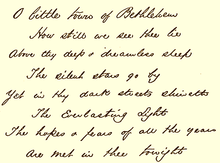O Little Town of Bethlehem
| O Little Town of Bethlehem | |
|---|---|
 Author's manuscript of first stanza | |
| Genre | Christmas carol |
| Written | 1868 |
| Text | Phillips Brooks |
| Based on | Micah 5:2 |
| Meter | 8.6.8.6.7.6.8.6 |
| Melody | "St. Louis" by Lewis Redner, "Forest Green" by Ralph Vaughan Williams |
"O Little Town of Bethlehem" is a
Words
The text was written by Phillips Brooks (1835–1893), an
Music
St Louis
Redner's tune, simply titled "St. Louis", is the tune used most often for this carol in the United States.[1] Redner recounted the story of his composition:[1]
As Christmas of 1868 approached, Mr. Brooks told me that he had written a simple little carol for the Christmas Sunday-school service, and he asked me to write the tune to it. The simple music was written in great haste and under great pressure. We were to practice it on the following Sunday. Mr. Brooks came to me on Friday, and said, "Redner, have you ground out that music yet to 'O Little Town of Bethlehem'?" I replied, "No", but that he should have it by Sunday. On the Saturday night previous my brain was all confused about the tune. I thought more about my Sunday-school lesson than I did about the music. But I was roused from sleep late in the night hearing an angel-strain whispering in my ear, and seizing a piece of music paper I jotted down the treble of the tune as we now have it, and on Sunday morning before going to church I filled in the harmony. Neither Mr. Brooks nor I ever thought the carol or the music to it would live beyond that Christmas of 1868.
My recollection is that Richard McCauley, who then had a bookstore on Chestnut Street west of Thirteenth Street, printed it on leaflets for sale. Rev. Dr. Huntington, rector of All Saints' Church, Worcester, Mass., asked permission to print it in his Sunday-school hymn and tune book, called The Church Porch,[2] and it was he who christened the music "Saint Louis".

Forest Green
In the United Kingdom and

Other versions
Two versions also exist by Henry Walford Davies, called "Wengen", or "Christmas Carol".[6] "Wengen" was published in Hymns Ancient and Modern in 1922,[7] meanwhile "Christmas Carol" is usually performed only by choirs rather than as a congregational hymn. This is because the first two verses are for treble voices with organ accompaniment, with only the final verse as a chorale/refrain harmony. This setting includes a recitative from the Gospel of Luke at the beginning, and cuts verses 2 and 4 of the original 5-verse carol. This version is often performed at the service of Nine Lessons and Carols in King's College, Cambridge.[8]
William Rhys-Herbert included a new hymn-tune and harmonization as part of his 1909 cantata, Bethany.
The song has been included in many of the Christmas albums recorded by numerous singers in the modern era.
"
A new tune for O little Town of Bethlehem called "Enmore" by the composer Philip Trumble was first published in 1987 [10] Philip Trumble's was also published in the 2022 publication Christmas Praise [11][12]See also
References
- ^ a b Louis F. Benson, "O Little Town of Bethlehem". Studies Of Familiar Hymns, First Series (Philadelphia: The Westminster Press. 1924), 11.
- ^ William Reed Huntington (ed.) The Church Porch: A Service Book and Hymnal for Sunday Schools (E. P. Dutton, 1882)
- ^ a b Vaughan Williams' Manuscript of "The Ploughboy's Dream" at the Vaughan Williams Memorial Library Full English collection, accessed 30 March 2014
- ISBN 978-1-85928-387-5p. 111
- ^ Mark Browse, "O Little Town", hymntunes.blogspot.co.uk, 12 July 2015
- ^ "Christmas Carol", Davies, Hyperion Records
- ^ Hymns Ancient and Modern (London: William Clowes and Sons, Ltd., 1922)
- ^ Order of Service Archived 2010-11-01 at the Wayback Machine, A Festival of Nine Lessons and Carols 1999, King's College Cambridge 1999.
- ^ Mayaab, Philips. "From Mainstream to CCM: Cliff Richard's Story". ccmclassic.com. New Hope Management. Retrieved 29 September 2019.
- ^ CAROL PRAISE MARSHALL PICKERING ISBN 0-551-01452-0
- ^ "Praise!". www.praise.org.uk.
- ^ ISBN 9781739156305
External links
 Media related to O little town of Bethlehem at Wikimedia Commons
Media related to O little town of Bethlehem at Wikimedia Commons- O Little Town of Bethlehem: Free scores at the Choral Public Domain Library (ChoralWiki)
- "O Little Town of Bethlehem" (Davies): Scores at the International Music Score Library Project
- Score of "Wengen": (pt 1, pt 2)
- "O little town of Betlehem" (audio) on YouTube, sung to the tune "Forest Green" (arr. Vaughan Williams, desc. Thomas Armstrong) by the Choir of King's College, Cambridge

